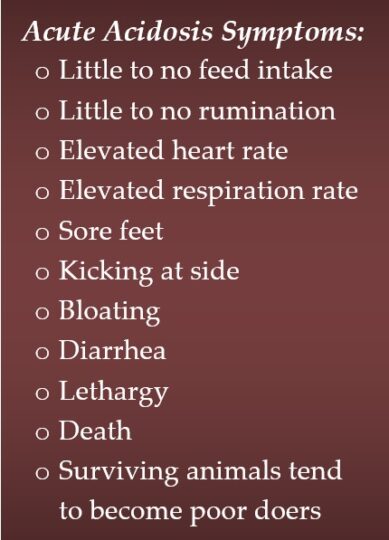Acidosis boils down to two main issues: the overproduction of acid within the rumen and decreased buffering of the rumen due to decreased saliva flow. The causes of these issues can vary and are cumulative. It is the most common nutritional disorder seen on cattle operations, while also being one of the easiest to prevent with proper management.

Acidosis occurs when the pH of the rumen falls below 5.5. When the pH drops, rumen motility slows which reduces appetite. The pH changes due to the acid-producing bacteria flourishing, the more acid the bacteria produce the worse the acidosis gets. The rumen wall will then begin to absorb the acid causing metabolic acidosis – in severe cases this can lead to shock and death.
There are two types of acidosis: acute and sub-acute. In beef animals, acute acidosis is more commonly recognized and often results in death. Acute acidosis, sometimes referred to as “grain overload”, typically occurs when cattle overconsume large amounts of rapidly fermentable grain including cereal grains, fine ground corn, etc. It can also be triggered by an animal going off feed for any reason (weaning or transportation stress, sickness/injury, heat stress, etc.) and then returning to feed and binge eating. A majority of acute acidosis cases appear in the feedlot sector, though cases have been seen in cow-calf herds if grazing cereal crops or when supplementation programs are inconsistent.
Cattle with acute acidosis will be noticeably sick and require interventions to reduce symptoms to prevent further damage or death. Make sure the affected cattle have access to plenty of water, free choice sodium bicarbonate, and long stem roughage. Consult your veterinarian for specific treatment options.
Prevention is key when it comes to acidosis. Maintain a healthy rumen environment with consistent and balanced feed intake. Provide cattle with sufficient effective fiber sources. If using bedding as the forage source, make sure you are bedding thoroughly and regularly. When feeding corn/pellet diets, stick with whole corn as opposed to cracked or ground. Processing increases digestibility rate leading to quicker drops in rumen pH. When feeding high energy grain diets, utilize step up diets. This allows for the rumen bacteria to acclimate to the hotter diet. Also, consider the use of ionophores. Ionophores, including Rumensin and Bovatec, are antimicrobials that can be fed to cattle to improve nutrient availability, prevent coccidiosis, and increase feed efficiency and weight gain. A benefit of ionophores is that they reduce dry matter intake and variability in intake thus stabilizing rumen pH fluctuations. Other preventive measures include: utilizing rumen buffers (sodium bicarbonate), feeding yeast products, increasing feeding frequency and avoiding variability, prioritizing bunk management, and monitoring cattle behavior at feeding times.
Keep in mind, for every animal showing clinical signs there are likely several more affected sub-clinically. Work with your Famo Feeds dealer or nutritionist on strategies to prevent acidosis on your operation.
Acidosis – Acute Development
Famo Feeds • 446 Industrial Dr • Freeport, MN • 800-450-2145 |

